Air compressor fall into two main categories: Reciprocating and Rotary. The principal types of compressor within these categories are shown below:
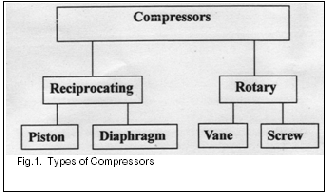
International Journal of Scientific & Engineering Research, Volume 4, Issue 9, September-2013 1443
ISSN 2229-5518
ANALYTICAL DESCRIPTION OF PNEUMATIC SYSTEM
Karan Dutt
Abstract--This paper mainly talks about PNEUMATICS’ working and components. The main emphasis is given on its various components’ functioning and working. Pneumatics is a section of technology that deals with the study and application of pressurized gas to produce mechanical motion. Pneumatic systems are used extensively in industry, and factories are commonly plumbed with compressed air or compressed inert gases. This is because a centrally located and electrically powered compressor that powers cylinders and other pneumatic devices through solenoid valves can often provide motive power in a cheaper, safer, more flexible, and more reliable way than a large number of electric motors and actuators. This paper also talks briefly about the ELECTROPNEUMATIC system and all the components and the symbols associated with it.
— — — — — — — — — — — — — — — — — — — —
PNEUMATICS - An over view
Fluid power system using air as a medium for developing, transmitting, controlling and utilizing power is commonly referred to as Pneumatics.
Pneuma is a Greek word means Breath or Wind or Air.
Pneumatics means the study of air movement and air phenomena. Today it is not possible to imagine the modern industry without using Pneumatics for the automation. It finds application in the diverse branch of the industry. The real practical industrial application of Pneumatics in production dates back to about 1950.
In Pneumatics in the majority of applications compressed air is used for one or more of the following functions.
• The use of sensor to determine status of process.
• Information processing.
• Switching of actuators by means of final control
elements.
• Carrying out of work.
————————————————
Karan Dutt is currently pursuing B. Tech in Mechanical and Automation Engineering in HMR Institute of Technology and Management, G.G.S.I.P. University, Delhi, India, E-mail: karandutt0900@gmail.com
• Linear
• Swivel
• Rotary.
• Clamping
• Shifting
• Positioning
• Orienting
• Opening of system valves for Air, Water or
Chemicals
• Packaging
• Door or Chute control
• Forming operations like bending, drawing etc.,
• Stamping and embossing of components
• Feeding and Transfer of materials.
• Turning and inverting of parts.
• Stacking of components.
• Sorting of parts.
• Spot welding
• Pick and place operations
• Work or tool feeding in Machine tools
• Dental drills etc.
IJSER © 2013 http://www.ijser.org
International Journal of Scientific & Engineering Research, Volume 4, Issue 9, September-2013 1444
ISSN 2229-5518
• Air is available practically everywhere for compression, in unlimited quantities.
• Air can be easily transported in pipelines,
Even over larger distances. It is not
necessary to return the compressed air to the storage.
• A compressor need not be in continuous operation. Compressed air can be stored in and removed from a reservoir.
• Compressed air is insensitive to temperature fluctuations. This ensures reliable operation even under extreme conditions of temperature.
• Compressed air offers no risk of
explosion or of fire, hence no expensive protection against explosion is required.
• Compressed air is clean since any air which
escapes through leaking pipes or elements
does not cause contamination.
• The operating components are simple in
construction.
• Compressed air is a very fast working
medium; cylinders have working speed up to
2m/sec.
• Pneumatic tools and operating
components can be loaded to the point of stopping and they are therefore over load safe.
• Compressed air requires good preparation.
Dirt and condensate should not be present.
• Due to compressibility it is not always possible to achieve uniform and constant piston speeds with compressed air.
• Compressed air is economical only up to a
certain force requirement. Under the normal working pressure of 6-7 bar and dependent on the travel and speed, the output limit is between
2000 - 3000 kgs.
• The exhaust air is loud. This problem has now,
however, been largely solved due to silencers.
• Compressed air is relatively expensive means
of conveying power. The high energy costs are partially compensated by inexpensive components and higher performance.
• A comparison with other forms of energy is an
essential part of the selection process when considering pneumatics as a control or working medium. This evaluation embraces the total system from the input signals (sensors) through the control part (processor) or to the output devices (actuators).
• Work or output requirements
• Preferred control methods
• Resources and expertise available to support the project
• Systems currently installed which are to be
integrated with the new project
Pneumatic cylinder, Rotary actuators and Air motors provide the force and movement of most pneumatic control systems, to hold, move, and form and process material. To operate and control these actuators, other pneumatic components are required i.e. air service units to prepare the compressed air and valves to control the pressure, flow and direction of movement of the actuators.
A basic pneumatic system consists of two main sections:
• The Air Production and
• Distribution system
The component parts and their main functions are:
1. Compressor
Air taken it, at atmospheric pressure is compressed and
delivered at a higher pressure to the pneumatic system. It
thus transforms mechanical energy into pneumatic energy.
2. Electric Motor
Supplies the mechanical power to the compressor. It
transforms electrical energy into mechanical energy. ;
3. Pressure Switch
Controls the electric motor by sensing the pressure in the
tank. It is set to a maximum pressure at which it stops
the motor and a minimum pressure at which it restarts it.
4. Check Valve
IJSER © 2013 http://www.ijser.org
International Journal of Scientific & Engineering Research, Volume 4, Issue 9, September-2013 1445
ISSN 2229-5518
Lets the compressed air from the compressor into the tank and prevents it leaking back when the compressor is
stopped.
5. Tank
Stores the compressed air. Its size is defined by the
capacity of the compressor The larger the volume, the
longer the intervals between compressor runs.
6. Pressure Gauge
Indicates the tank pressure.
7. Auto Drain
Drains all the water from the tank without supervision.
8. Safety Valve
Blows compressed air off if the pressure in the tank
should rise above the allowed pressure.
9. Refrigerated Air Dryer
Cools the compressed air to a few degrees above
freezing point and condenses most of the air humidity.
This avoids having water in the downstream system.
10. Line filter
Being in the main pipe, this filter must have a minimal
pressure drop and the capability of oil mist removal. It
helps to keep the line free from dust, water and oil.
1.Air Take off
For consumers, air is taken off from the top of the main
pipe to allow occasional condensate to stay in the main pipe, when it reaches a low point water off from beneath the pipe will flow into an Automatic drain and the condensate will be removed.
2. Auto Drain
Every descending tube should have a drain at its lowest
point. The most efficient method is an auto drain which prevents water from remaining in the tube.
3. Air Service Unit
Conditions the compressed air to provide clean air at optimum pressure and occasionally adds lubricant to extend the life of those pneumatic system components which need lubrication.
4.Directional Valve
Alternately pressurizes and exhaust the cylinder
connections to control the direction of movement.
5. Actuator
Transforms the potential energy of the compressed air
into mechanical work. The figure shown is a linear cylinder; it can also be a rotary actuator or an air motor.
6. Speed Controllers
Allow an easy and step less speed adjustment of the
actuator movement.
Air compressor converts mechanical energy of an electric motor or any prime mover into the potential energy of compressed air.
Air compressor fall into two main categories: Reciprocating and Rotary. The principal types of compressor within these categories are shown below:
COMPONENTS OF A PNEUMATIC SYSTEM
A Pneumatic system can be broken down into a number
of levels representing hardware and signal flow. The
various levels form a control path for signal flow from the signal (input) side to the work (output) side.
IJSER © 2013 http://www.ijser.org
International Journal of Scientific & Engineering Research, Volume 4, Issue 9, September-2013 1446
ISSN 2229-5518

Single acting cylinders are used for clamping, marking or ejecting purposes. They have a somewhat lower air consumption compared with the equivalent size of double acting cylinders. However there is an reduction in thrust due to the opposing spring force, and so a larger bore required. Also accommodating the spring results in a longer overall length and !limited stroke length.
Cylinder or Actuator is an output device, which converts Pneumatic energy to Mechanical energy. The work done by a pneumatic actuator can be linear or rotary. Linear motion is obtained by piston cylinders, where as Reciprocating motion with an angle up to 270° by vane or rack and pinion type actuators and continuous rotation by air motors.
I. Linear Cylinders
Pneumatic cylinders of varying designs are the most common power components used in pneumatic automation. There are two basic types from which special constructions are derived.
• Single acting cylinders with one air inlet to
produce a power stroke in one direction.
• Double acting cylinders with two air inlets to
produce power strokes during extension and
retraction
II. Single Acting Cylinder
A single acting cylinder develops thrust in one direction
only. The piston rod is returned by a return sprint or by external force from the load or spring. It may be a puss or pull type.
1. Piston
2. Piston rod
3. Compression spring
4. Front end cap
5 Rear end cap
6 Piston rings
7 Stop
8 Barrel
III. Double Acting Cylinder
With this actuator, thrust is developed in both
extending and retracting directions as air pressure is
applied alternately to opposite sides of a piston. The thrust available on the retracting stroke is reduced due to the smaller effective piston area, but is only a consideration if the cylinder is to pull the same load in both the directions.
1. Piston
2. Piston rod
3 Front end cap
4. Rear end cap
5. Piston rings
6. Rod seal / Scraper
t
IV. Cushioning
Pneumatic cylinders are capable of very high speed and
considerable shock forces can be developed on the end of
the stroke. Smaller cylinders often have fixed cushioning i.e. rubber buffers, to absorb the shock and prevent internal damage to the cylinder. On large cylinders, the impact effect can be absorbed by an air cushion that decelerates the piston over the last portion of the stroke. This cushion traps some of the exhausting air near the end of the stroke before allowing it to bleed off more slowly though an adjustable needle valve.
IJSER © 2013 http://www.ijser.org
International Journal of Scientific & Engineering Research, Volume 4, Issue 9, September-2013 1447
ISSN 2229-5518
Piston Force- The piston force exerted by a working element is dependent on the air pressure, the cylinder diameter and the frictional resistance of the sealing components.
The theoretical piston force is calculated using the following formulae:
• Allowing the passage of air and directing it to particular air lines
• Cancelling air signals as required by blocking their passage and / or
• Relieving the air to atmosphere.
Symbols associated with the PNEUMATIC System: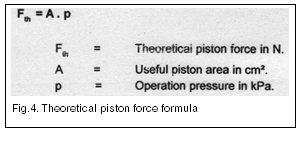

In practice, the effective piston force is significant in
calculating the effective piston force, the frictional resistance must be taken into account. Under normal operating conditions (pressure range 400-800kli 4-8bar), the frictional forces may be assumed to be between 3-20% of the calculated force.
Single acting cylinders
Fn = A. p - (FR+FF)
Double acting cylinders (forward stroke) Double acting
cylinders (return stroke)
Fn = A. p- FR Fn
Where,
F~ = Effective piston force in Newton (N) A = useful piston area in cm= = D2 xn/4
A' = useful piston ring area in cm2 =(D2 - d2) x rc/4
p= operation pressure (kPa, 105 N/m',
bar)
FR = frictional force (3-20%) in Newton
(N)
FF = force of return spring in Newton (N)
D= cylinder diameter in cm s
.
DIRECTIONAL CONTROL VALVES (D C VALVES)
Directional control valves are devices which influence the path taken by an air stream. Normally this involves
one or all of the following:
IJSER © 2013
International Journal of Scientific & Engineering Research, Volume 4, Issue 9, September-2013 1448
ISSN 2229-5518

Integration of pneumatic and electrical technologies has played an important part in the development of a large range of industrial automation solutions. More than* ever, the need for cost effective and efficient production systems demands that machine cycle times are minimized. An electro pneumatic control offers a number of advantages to the developer of control systems. Where signals are transmitted over great distances in a control system, the time between signal transmission and signal reception is minimized using electricity as the transmission medium.
Where growth in production is anticipated, the incorporation of solenoid actuated valves also provides the developer with the option of developing the system to incorporate controller that allows the system operating cycle to be altered as production requirements change.
.
An overview
Electrical components used in the system basically have the following roles.
1. Sensing information.
2. Processing information.
The sensing of information can be carried out by roller actuated limit switches, magnetically actuated switches or electronic sensors-that sense whether or not a particular operation has occurred. This information is then passed to the processing device, which may be a relay. The processor then has the task of directing and modifying its received signal to drive the output stage of the system. This output stage generally has two parts Firstly a final control element that is electrically actuated with a pneumatic output and secondly the pneumatic actuator.
• Packaging
• Feeding
• Metering
• Door and hopper control
• Material transfer
• Sorting of parts
• Component stacking
• Stamping, shearing and embossing
parts etc
IJSER © 2013 http://www.ijser.org
International Journal of Scientific & Engineering Research, Volume 4, Issue 9, September-2013 1449
ISSN 2229-5518
Components in a control system can be identified as belonging to four basic groups The primary levels of an electro pneumatic system structure are
• Energy supply (Compressed air and electrical)
• Input elements (Limit switches/push buttons/proximity sensors)
• Processing elements(Switching logic, solenoid
valves, pneumatic to electric converters)
• Actuators and final control
elements(cylinders, motors, directional control valves)
Components in the system are represented by
symbols which indicate their function. The symbols are then combined to represent a solution for a particular control task and this representation forms the circuit diagram
The following figure shows a typical component
placement of an electro pneumatic control system
Electro pneumatic components
Electro pneumatic components fall under the following category
• Actuators
Pneumatic cylinders, Rotary actuators, Lamps
/Buzzers
• Control Elements
Solenoid actuated directional control valves,
Relays
• Processors
Solenoid actuated directional control
valves, Logic elements, Pneumatic/electric converter, Relays
• Sensors
Limit switches, push buttons, proximity
sensors
• Energy supply ' Compressor, AC or DC power supply
As the industrial automation control system is more and more complicated. It is necessary to make the pneumatic component electrically interact with _ the control system
Frequently .used electro pneumatic components are
• Cylinder switches
• Pressure switches
• Solenoid valves
Cylinder switches: These switches detect the magnetic
ring of a cylinder piston and make an electrical contact
signal for switching
Reed switch: A reed switch consists of two tiny, leaf springs (reeds), hermitically sealed into a glass tube. The outer ends provide the electrical connection of the switch. The two ends inside the tube are silver or gold plated for a better electrical contact. They overlap with a very small clearance between them. If the switch comes into a magnetic field and the two blades pick up different polarity they attract each other and make an electrical contact (Switch closed)
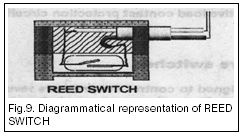 .
.
Static switch: In high frequency operation where millions of cycles are reached in a relatively short time, a static switch should be used. One can compare the working principle of such a switch roughly with e.g. a light sensing resistor. Which has an extremely high resistance in the dark (open contact),but relatively low one (Closed contact) if exposed to light. The difference is that the switching part of a static switch is varied by magnetic field instead of light. In using such a switch we must be aware that it will be a part of the controlled electronic circuit and therefore bound to a fixed specified voltage and current
IJSER © 2013 http://www.ijser.org
International Journal of Scientific & Engineering Research, Volume 4, Issue 9, September-2013 1450
ISSN 2229-5518
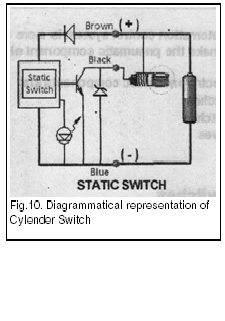
Solenoid valves:
A valve is a device, which receives an external
command to release, stop or redirect the fluid that flows through it Directional control valves in particular as their name implies control fluid flow direction. They are used in pneumatic circuits to provide control functions which
• Control direction of actuator motion
(power valve)
• Perform logic control function(AND,OR,NOT function)
• Stop and start fluid flow (on off valve) .
• Sense machine and actuator position
(Limit valves)
DC valves are classified according to their specific design characteristic
Cylinder switches advantages
• Quiet in operation
• Longer life time
• Fast response time
• Maintenance free
• Reed contacts free from corrosion and
contamination
Disadvantages
• Current or voltage that can be switched is limited
• High contact wears (arcing) if the inductance of
the connected circuit is relatively high .
• For a inductive load contact protection circuit 'is
required ,
Pressure switches
These are designed to control the pressure level in a pneumatic circuit. The switch transforms the pressure change into an electrical signal. When a preset pressure is reached the electrical control changes state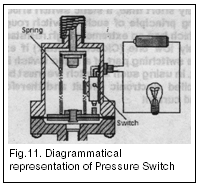
IJSER © 2013 http://www.ijser.org
1. internal valve mechanism which directs the flow of the fluid Such mechanisms can be either be a poppet disc, poppet ball, sliding spool, a rotary plug or a combination of poppet and spool
2. Number of switching positions/ways. These are usually two or three. Some valves may provide more than three and in exceptional cases up to six switching positions(selector valves)
3. Number of connection ports. These ports connect the pressure lines to the internal flow channels of the valve mechanism and often also determine flow rate through it
4. Method of valve actuation. It causes the valve
mechanism to move into an alternative
switching position.
International Journal of Scientific & Engineering Research, Volume 4, Issue 9, September-2013 1451
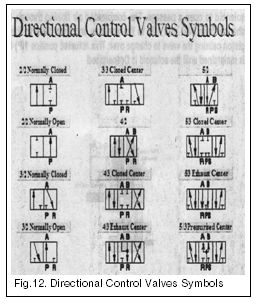
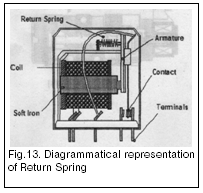
ISSN 2229-5518
Contacts: Contacts are most important parts of relay. Their operation and characteristics are influenced by various factors such as contact materials, applied voltage and current, load type, switching frequency.
I. Relays
Relay is an electrically operated switch. It consists
of a coil with an iron core and one or more movable
contacts, switched by the magnetic field of the coil assembly. General purpose relays specially designed for users demanding small size sturdy construction and high electrical capacity. Mechanisms are furnished in polycarbonate dust proof enclosure and are recommended for a multitude of electrical control applications for their reliability and compact size. When the voltage is applied to the coil an electric current flows through the coil, a magnetic field builds up and causes the armature to be pulled into the core of the winding. The switching position is maintained as long as the voltage is applied. When the voltage is removed- the armature is restored to its original position by return spring
Relay functions
• Changing from a NC to NO contact
(Inversion)
• Multiplying contacts from one to any reasonable number of contacts
• Power amplification
• Voltage change
• Memory function
Plug in relay
Features
• These are used in low level circuits
• Dust free tight case
• Terminals arrangement facilitates
attachment to standard relay socket
Printed Circuit Board relay
Features
• Specially designed for users demanding small size and high electrical capacity
• AC or DC actuation with voltages up to 240
VAC or 120 V DC
Solid state relay
Features
• Unlimited lifetime: Unlike electromechanical relays and contactors, solid state relays have no moving parts and their life
is virtually unlimited
Latching relay: Features
IJSER © 2013 http://www.ijser.org
International Journal of Scientific & Engineering Research, Volume 4, Issue 9, September-2013 1452
ISSN 2229-5518
• Low power consumption due- to mechanical latch for economic operation
• Relays with mixed coil specification can be produced
Timing relays
• The function of this type of relay is to close or open 0)e contacts whether normally open or normally closed contacts, in -3 circuit after a particular time delay which is adjustable.
Types
1. ON delay
Here when the relay is energized the preset time starts to elapse. Once the preset time is reached the switching position is changed. The position of contacts is maintained as long as voltage is applied.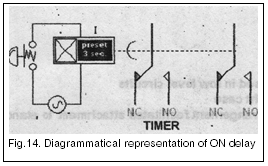
2. OFF -- Delay
In this timer as soon as the timer is energized, the contacts change its position. The time elapse will start only when the timer is triggered OFF.
counter counts in descending order.
4. Reversible counters - here the counter shall be programmed for either UP or DOWN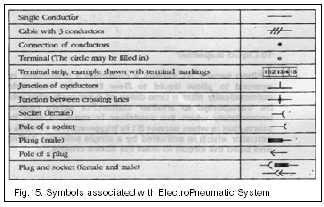
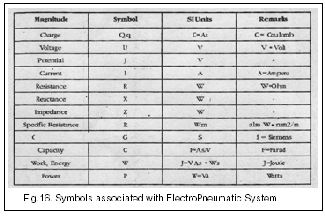
II. COUNTERS
Counters are devices which count the change of
electrical signal state at the counter input. The counters are settable so that if the count exceeds the set value, the switching position of the output contact is changed. In Pneumatics, Counters are used for counting the number of parts processed, or the number of cycles. The
Counters shall be of Electromagnetic type or Solid state. '
The following types of counters are used
1. Preset Counter - here the contacts actuate and deliver a switching signal when the preset
time is over. ' .
2. UP- Counters - here the counter counts in ascending order
3. DOWN Counter - here the
References
IJSER © 2013 http://www.ijser.org
International Journal of Scientific & Engineering Research, Volume 4, Issue 9, September-2013 1453
ISSN 2229-5518
1) Compressed Air Operations Manual, ISBN 0-07-
147526-5, McGraw Hill Book Compan.
2) Festo’s workbook on electro pneumatics.
3) Festo’s workbook on pneumatics.
4) Stacy, Chris, practical pneumatics, 1998.
5) KMC Controls. "Air Today, Digital Tomorrow: Pneumatic to BAS Conversions"
IJSER © 2013 http://www.ijser.org